Companies on a Mission, Discover How These Powerhouse Brands Bring Their Brand Mission to Life
/0 Comments/in Brand Mission /by Lorraine CarterPurposeful Brands: Why Customers Are Prepared to Pay More
/0 Comments/in Brand Mission, Brand Profiling & Positioning, Brand Purpose, Brand Strategy, Brand Values, Branding /by Lorraine CarterA quick answer please, if you can, to this question: “What does your brand really stand for?” in other words “What’s your brand purpose?”
If you hesitate to succinctly define the mission, vision, and values behind your brand – the primary raison d’être for your brand’s existence — your brand purpose — you can be certain that customers and potential new customers are missing the point entirely too. This is why it’s critical to codify and map out your brand so you are highly visible, stand out, can clearly articulate your brand purpose and deliver an unforgettably great customer experience.
In other words, if customers can’t meaningfully differentiate your brand from your competitors they will default to decisions based on price alone and they won’t pay a premium.
Because…when brands give, brands get.
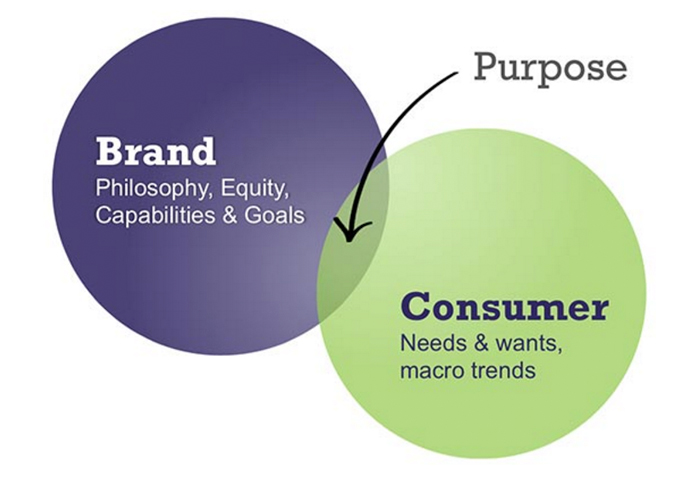
Image via Harbinger Communications
Who Decides and Defines: What is Brand Purpose
Mind you, it’s not as easy as it sounds. In 2014, according to The World Federation of Advertisers, consumers and marketers can be confused by the meaning and focus of brand purpose.[1]
“There is consensus that brand purpose is increasingly relevant,
but people and marketers don’t seem to agree on what it means.
Marketers see it as the bigger picture,
but people see it as what you do in daily life.” –
Stephan Loerke, managing director of the WFA
Where it Matters Most: Brand Purpose
Around the globe, consumers value brand purpose to varying degrees. Responses to whether consumers are willing to pay a premium for a product that supports good causes find Chinese with a very different view than Britons.[2] Nevertheless, this survey result means that even at the low end of the scale, more than one in four would loosen their purse strings for a brand with purpose.
| China | 80% |
| India | 70% |
| Brazil | 55% |
| Malaysia | 55% |
| USA | 39% |
| UK | 28% |
The concept of brand purpose is sometimes overlooked, or not clearly communicated, by small to medium-sized business owners and managers largely because the serious impact it has on accelerated business growth is not fully understood. Brand purpose can get lost in the frenetic pace of a busy startup. So it’s really important to underscore the huge influence brand purpose has on business outcomes, re-define the concept, and demonstrate its influence in commercial terms as the major driver behind perceived value, premium price points and higher sales.
Related: 10 Branding Tips From Silicon Valley on How to Be a Successful Startup Brand
Why Brand Purpose Matters
What do consumers think: Edelman’s brandshare studies[1] reveal that 92 percent of 11,000 consumers surveyed in eight countries want brands to share their values more effectively. Overall, 40 percent don’t think brands are doing enough to communicate and demonstrate purpose in “helping the world” in some way.
Related: Brand CSR: The Business Case for Successful Branding and Social Good
What do executives think: In a study issued by EY Beacon Institute and Harvard Business Review[2], 85 percent of the 474 business executives surveyed indicated they strongly agree they’re more likely to recommend a company with a strong purpose. They also strongly agreed, at 80 percent, that a company with shared purpose will have greater customer loyalty.
Related: CEO Brand Leadership: How Vision Drives Brand Growth
See the results in two diagrams: Brands that prioritize brand purpose benefit from stronger growth.[3]
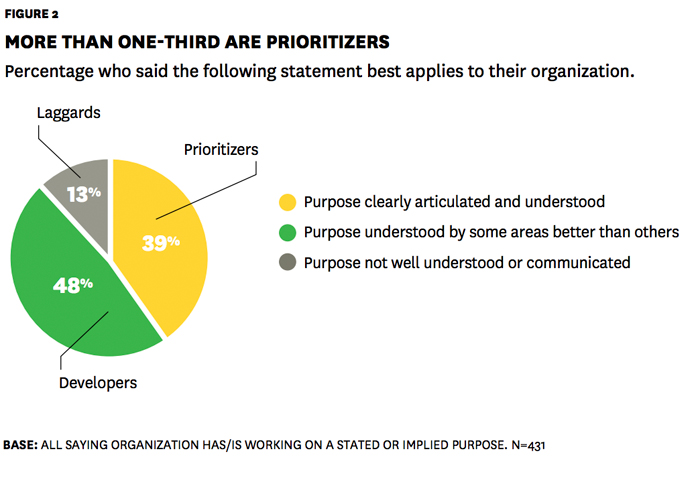
Image via Harvard Business Review
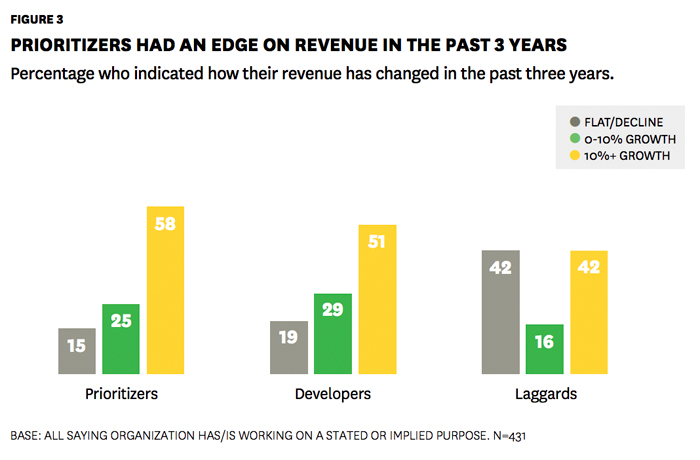
Image via Harvard Business Review
Defining Brand Purpose
What does this all mean? Brands with clarity of purpose outperform brands who lack it. To survive, brands must live and breathe through their core values because these are the fundamentals differentiating a brand from all its competitors so it stands head and shoulders above all the rest — and consequently commands a premium.
Author Simon Sinek sums the lessons from his book, “Start With Why” in his famous TED Talk about communicating brand purpose.

“People don’t buy what you do. They buy why you do it.”
– Simon Sinek
Sinek goes on to say, “The goal is not to do business with everybody who needs what you have; the goal is to do business with people who believe what you believe.”
Brand Purpose and Customers
The underlying message is that emotion drives purchase. Brands can engage primary customer emotions through articulating what the brand stands for, that is, purpose equals its mission, vision, and values.
The brand must reinforce this and bring it to life via experiential terms, such as customer service and brand touchpoints.
Related: Top 10 Brands for Customer Experience and What You Can Learn From Them
Be Different, Be Transparent Through Brand Purpose
Brand purpose is also a primary factor in brand differentiation because when it is sufficiently strong and compelling, it makes a brand highly visible and different compared to every competitor.
Simplistically speaking, if a brand’s purpose is aligned with the values of its ideal primary audience, those customers will naturally be attracted to it and want to buy it. People reward brands that openly share their values when those values are transparent. “Do we believe in the same things?” is what a customer wants to know. However, it is not the customer’s job to dig deep for that answer.
If brands don’t stand up for what they stand for — and diligently communicate it — nobody knows what the brand purpose is all about.
Brands with a purpose command the customer’s attention because, price point aside, a meaningful, emotional connection is valuable to the purchaser.
Related: Personality Matters: Bringing Your Brand to Life to Grow Profits
Whether a giant corporation or small business owner, it is critical to identify your brand purpose. Are you entrepreneurial? Find out what you truly stand for as an entrepreneur. Determine how to embody this purpose and communicate it to everyone your brand interacts with, including employees. You will enjoy higher profits while making your lasting mark on the world.
Related: The Age Of Internal Branding And Selling It From The Inside Out
If you want direction and support empowering you to transform your brand so you stand out with a strong brand purpose and increase your sales then the Persona Brand Building Blueprint™ Mastermind is the perfect fit for you.
This is a two-day brand building intensive shared with a small group of like-minded peers where you work on your brand with our leadership. In fact, over the two days, you reevaluate your brand, codify it and create your brand purpose and strategy to stand out and attract your ideal customers whether you’re revitalizing an existing brand or creating a new one.
At the end of the two-day Persona Brand Building Blueprint™ Mastermind you leave with absolute clarity on your brand purpose and your fully documented brand strategy ready for implementation in your business or organization.
This is not a theory based programme but a highly interactive fast-track programme where you work intensively on your brand throughout the two days duration, under our tutelage, using our ten step system to:
- Completely re-evaluate your brand to make it much stronger so it’s highly visible enabling you to increase your profits
- Map out your brand in full so it’s codified and comprehensively documented to grow your business faster
- You leave with your total brand road map or GPS of your brand empowering you to manage your brand, stand out and attract your ideal customers so you multiply your sales
Outcome: Your brand transformed so you can increase sales.
If your team is larger and you’d like to include everyone’s’ participation in the Persona Brand Building Blueprint™ Mastermind then we also run in-house private client brand building intensives tailored to your bespoke requirements so you’re empowered to take your business further a lot faster.
Want to know more?
Give us a call T: +353 1 8322724 (GMT 9:00 – 17:00) to find out more and discuss your preferences or send us an email to [email protected]

Codify and build your highly visible, profitable brand at the Persona Brand Building Blueprint™ Mastermind with Lorraine Carter
Examples of Explicit Brand Purpose
Dove and Levi Strauss are two brands that articulate brand purpose extremely well, fueling the emotional factors that drive purchase decisions.
Here we delve into these two examples of successful brands whose achievements and prosperity are largely underpinned by very compelling brand purpose. While these are not small business examples, there are reasons tied to brand purpose that explain how these companies grew larger and more profitable because of their strong brand purpose.
Related: 4 Reasons Why Your Business Profit Starts With Your Brand Mission
Brand Purpose Example: Dove Beauty Bar
It’s been over a decade since Unilever launched the groundbreaking “Campaign for Real Beauty” for Dove.
Brand Purpose: “To educate and inspire girls and women to embrace a wider definition of beauty.”[4]
Dove Real Beauty
“You’re more beautiful than you think,” was one early example. Following 19 million views on YouTube alone, its purpose of making women feel better about themselves launched the Dove Self-Esteem Project.
Result: “Since the inception of the Campaign for Real Beauty we have seen a significant positive shift in brand perception…Dove is seen both as a leader in the personal care company, as well as a leader in the Real Beauty conversation.”
Dove has achieved a return on investment that cannot be measured solely in uplift in the sale of bars of soap, although that’s occurred as well. Just ask one of their 27 million followers on Facebook.
In 10 years, the campaign, which Ad Age tapped as the best of the 21st century, has reportedly helped boost Dove sales from $2.5 billion to $4 billion, says the publication.
Dove Says:
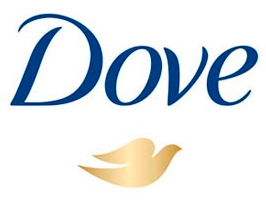
Image via Dove
“…11 years since we launched the Dove Self-Esteem Project, more than 625,000 teachers have delivered a Dove self-esteem workshop and more than 1.5 million parents have engaged with our online content. We’ve already helped 19.4 million young people in 138 countries. But we won’t stop there. Our global mission is to reach 20 million more by 2020.”
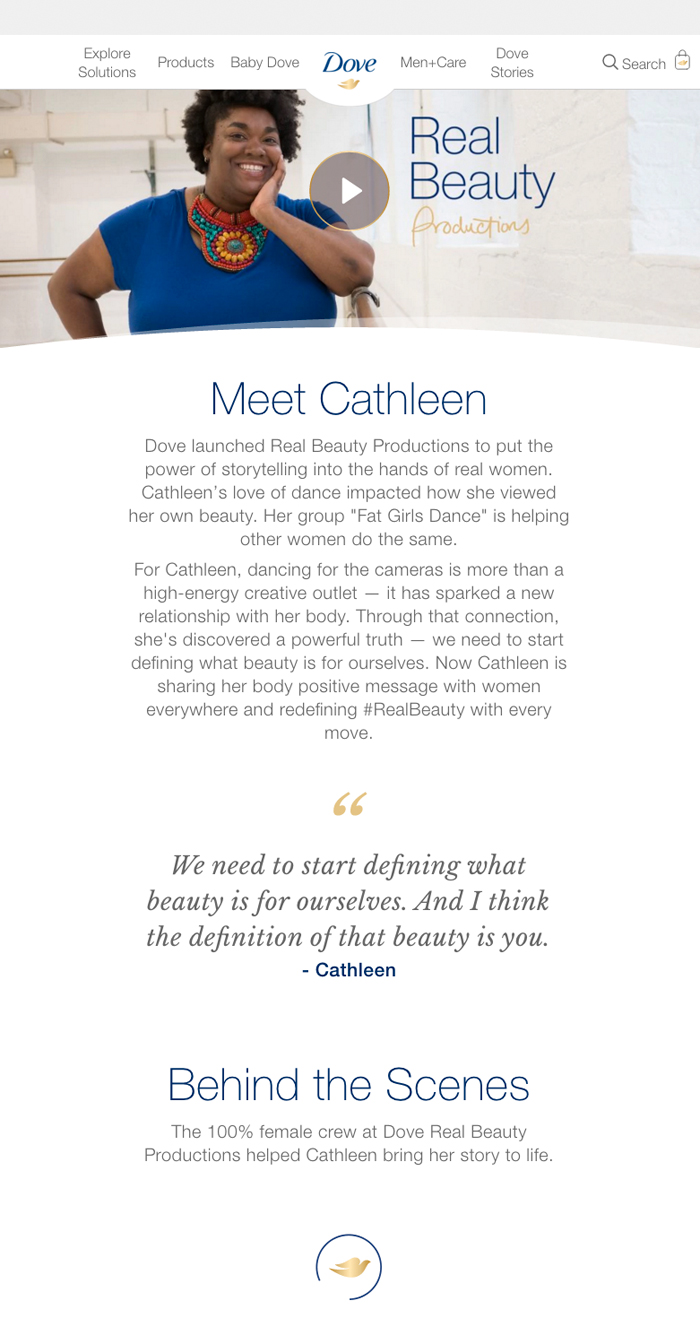
Image via Dove
What’s Next: Dove Real Beauty Productions launched in 2017 to bring touching real stories from real women to life in mini-videos. Meet Kylee, Meet Cathleen, and so on present revealing self-portraits, bravely challenging narrow definitions of “real beauty.”
How Much: At 6 bars of soap for $6.88, Dove Beauty Bar isn’t a costly item. But, $4 billion is a lot of soap. Clearly, women drawn in by the self-esteem campaign haven’t been concerned about getting another brand of soap for a few cents less.
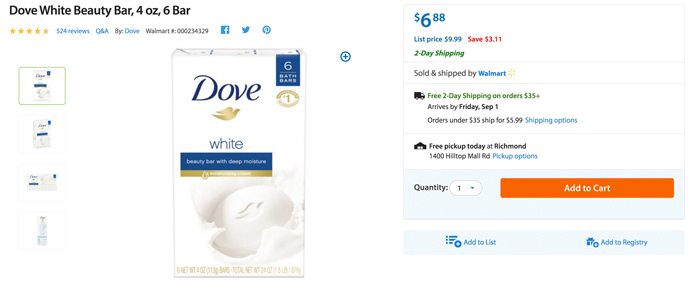
Image via Walmart
Brand Purpose Example: Levi’s
In the mid-20th century, former CEO Walter Haas articulated Levi’s brand purpose: “Each of us has a capacity to make business not only a source of economic wealth but also a force for social and economic justice.”
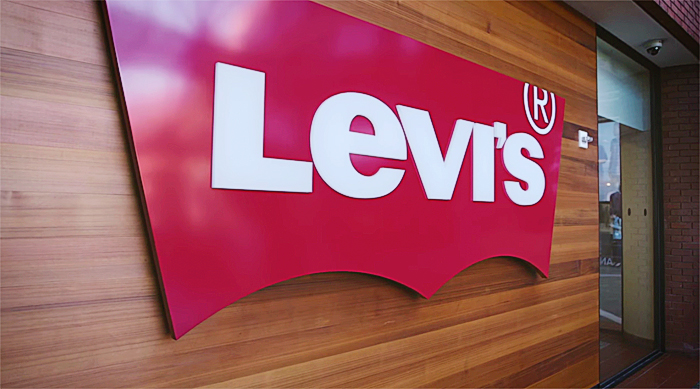
Image via Levi Strauss & Co.
Levi’s History: A brand’s history is “secretly seductive,” suggests Edelman. It can help to define purpose, as in why was the brand born in the first place? In the case of Levi’s, that answer is embedded in immigration, the nation’s westward expansion, family business, the determination and grit of its early nation builders, coupled with the boom of California Gold Rush days.
Related: Family Business Branding and The Secret Drivers to Brand Success
Manufacturing the world’s first blue jeans in 1873, Levi Strauss had an instant hit, creating durable, tough pants that miners needed to withstand the wear and tear of the job. Brass rivets were added to the pockets.
Giving Back: Due to the early success of the company, a commitment to giving back to the community began in the mid-19th century with support for an orphanage. Three decades later, the 1906 San Francisco earthquake and fire destroyed Levi’s headquarters and two factories along with 80 percent of the city. The company responded by extending credit to its wholesale customers so they could get back on their feet and back in business.
Related: Brand CSR: The Business Case for Successful Branding and Social Good
The Levi Strauss Foundation
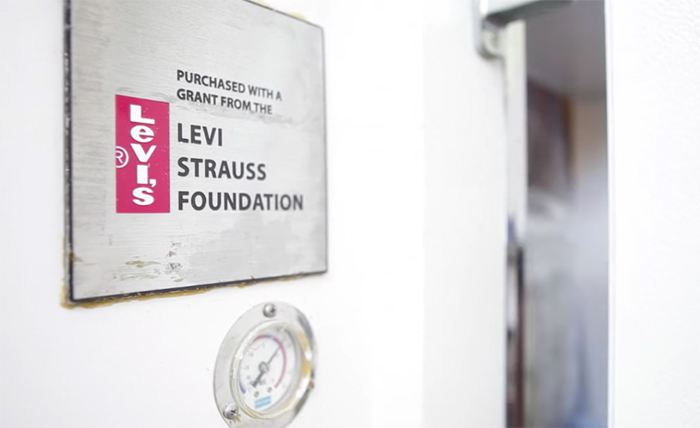
The Levi Strauss Foundation started with a 1897 donation to the University of California. From worker’s rights to environmental sustainability, the foundation continues its San Francisco Bay Area local commitments while making positive, major worldwide impact.
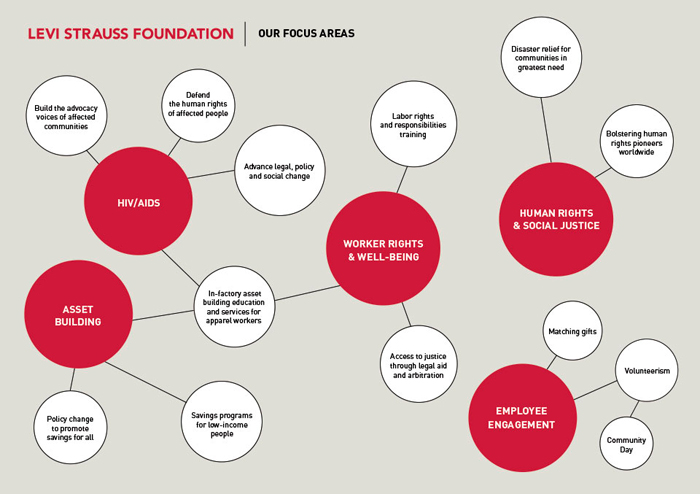
Image via Levi Strauss Foundation
Levi Strauss & Co. Says: Giving back never goes out of style. “We’re well-known for doing things that are right, that may be difficult…” says Tracey Panek, the company historian.
Levi’s Core Values endure and help shape the brand culture in a positive way.
- Empathy — walking in other people’s shoes
- Originality — being authentic and innovative
- Integrity — doing the right thing
- Courage — standing up for what we believe
Related: The Impact of Company Brand Culture On Driving Performance and Increasing Sales

La Cocina is a commercial kitchen incubator for low-income women in San Francisco. It gives them “access to financial, marketing and business opportunities that will allow them to transform their passion into full-fledged livelihoods for them and their families,” explains Levi Strauss Foundation, which supports the cause.
Articulating Brand Purpose: In 1990, the Harvard Business Review interviewed Robert D. Haas, then Chairman and CEO, the great-great-grandnephew of the company founder whose uncle, father, and grandfather all led the company before him.
At that time, he explained what the company had learned from its century-long tradition for social responsibility and how that reputation is inextricably linked to Levi’s success.
“In the past, however, that tradition was viewed as something separate from how we ran the business. We always talked about the “hard stuff” and the “soft stuff.” The soft stuff was the company’s commitment to our work force. And the hard stuff was what really mattered: getting pants out the door.
What we’ve learned is that the soft stuff and the hard stuff are becoming increasingly intertwined. A company’s values—what it stands for, what its people believe in—are crucial to its competitive success. Indeed, values drive the business.”
– Robert D. Haas
In the ongoing story of “Who We Are,” Levi Strauss shares its message about “not just in what we do, but how we do it.”
How Much: Nobody ever said Levi’s 501 are the least expensive jeans. An average pair of purchased in San Francisco in mid-2017 is $67. You can certainly get jeans for less.
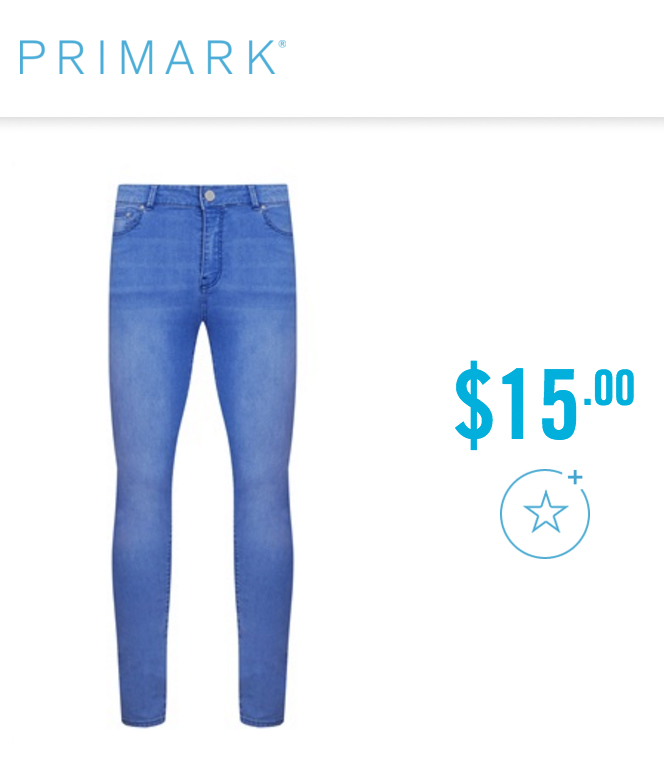
Image via Walmart
Financial Results: Levi’s financial results have been extraordinary over its 160 year lifetime. The 2016 Annual Report indicates that net revenue was $4.6 billion, representing 3 percent growth worldwide over the previous year.

Image via Levi Strauss and Co.
How to Build Your Brand’s Purpose
When working with our private clients we use the Personality Profile Performer™ System to develop key brand foundational elements for their brands. The outputs from the Personality Profile Performer™ then provide you with your brand blueprint or brand roadmap, together with the brand direction for your brand design application in brand collateral, brand communications strategy, training and so forth.
If you want direction developing your brand so you can increase your profits then take a look at our online brand building eprogramme called the Personality Profile Performer™. This online course takes you through all the key steps you need to implement as you build your brand, including your brand purpose. You can watch a free course preview here.
Notice that purpose is one of the key building blocks for a strong brand foundation. This part of the brand foundation provides the critical direction for brand strategy, and consequently, for high performance with the laser-focused results marketers seek. Here we aim to show you how a well-defined brand purpose is inextricably tied to stronger brand performance that commands a higher price point.
Alternatively, if you’d like professional direction to develop your brand purpose and would like to explore working with us then send us an email to [email protected] or give us a ring T: +353 1 8322724 (GMT hour 9:00 – 17:00). We’d very happy to speak with you.
Related: Brand Profiling – How Brand Performance and Purpose Are Inextricably Linked
Questions to Ask Yourself:
- Would you pay a premium for these brands? Can you see why people do?
- Is your brand purpose well defined and well articulated?
- Can your customers express your brand purpose? Can your employees?
- Does your brand purpose reflect authenticity?
- How does your brand demonstrate its brand purpose across multiple customer touchpoints?
- Is your brand focused on creating purpose that commands your customers’ attention and discretionary spend?
[1] https://www.edelman.com/insights/intellectual-property/brandshare/about-brandshare
[2] http://www.ey.com/Publication/vwLUAssets/ey-the-business-case-for-purpose/$FILE/ey-the-business-case-for-purpose.pdf
[3] Ibid.
[4] https://www.facebook.com/pg/DoveUS/about/?ref=page_internal
[1] http://adage.com/article/global-news/marketers-confused-meaning-focus-brand-purpose/292325
[2] Ibid.
4 Reasons Why Your Business Profit Starts With Your Brand Mission
/0 Comments/in Brand Culture, Brand Mission, Brand Profiling & Positioning, Brand Strategy, Branding /by Lorraine CarterIn just about any niche, competition is fierce. Yet many SME, SMB, mid-size to large companies neglect to develop and articulate their brand mission because they’re either not sure how to do it or don’t realise it’s importance.
This in effect means they have nothing of substance [beyond price fights] to attract their ideal customers, whether their audience is B2B or B2C. Your brand mission is one of the critical deciders in captivating your ideal customers so they don’t go to, or buy from your competitors.
When you’re clear on your company’s brand mission, it acts as the overall steering mechanism of the business.
The best companies in the world understand the value of brand mission. It is your brand mission that impacts key decision making, strategic planning, productivity, service and brand strategy and marketing direction.
The real secret of incorporating your brand mission though, is that it drives profit growth because your brand mission and everything that follows it is what attracts the right people – employees and customers; those who believe what you believe. And when you tap into what’s important to the right people, you make considerably more money.
Related: 6 Tips For Building Your Profit Growth Plan
What Does Brand Mission Mean?
Branding is all about human psychology and perception. It consists of different levels, like the brand vision which drives the other elements, including the mission. Brand mission answers the question of, “how do we achieve our brand vision?” It is the “who we are and what we do” of a company.
Let’s get one thing clear from the start though, your brand mission is not a dusty mission statement hanging on the corporate wall. Rather, it’s how the company carries out its mission.
The biggest benefits of developing a clear, strong brand mission are:
- Recognition. Even if your business slots into the small to medium sized, having consistent messaging, tone-of-voice, language, personality, look and feel makes it much easier to attract and remain front-of-mind in your ideal target customer.
- Professionalism. Branding your business makes you appear better, larger and more successful. It makes you more trustworthy, and trust is what makes people ultimately decide to buy.
- Purpose. The brand mission unites employees in one single purpose and makes the business stronger and more effective. When the employees of a company or organisation have a compelling purpose, a reason for being part of something bigger than themselves, then the drivers behind what they do are far more compelling and effective than mere economics alone. These emotional factors are far more potent because they’re the driver behind why people commit to buying something more expensive, working after hours when needed, going the extra mile and so forth. People need to feel that the work they do matters and is part of something bigger — a brand mission is the rallying call for this.
Related: The Age of Internal Branding and Selling From The Inside Out
In the video below, Simon Sinek talks about the psychology of employee fulfillment. A brand mission unites the humans in your company and gives them a sense of common purpose, which ultimately leads to higher productivity and superior quality work.
This is a vital point because much of the monetary benefits derived from a strong brand mission are the consequence of how employees respond when they share a greater sense of purpose.
What Makes A Strong Brand Mission?
A strong brand mission must;
- Be really clear
- Easy to understand
- Represent a higher truth
- Create a lasting impact in the world
- Have meaning beyond the money
Developing a brand mission is about pulling together your company’s vision, strategy, future product and service development, together with its operational and marketing priorities.
By using strategic thought, creativity, expression, and innovation, it combines:
- The company mission
- The customer mission
- The business mission
Essentially, your brand mission is your framework for action, your raison d’être behind the what, why and how for everything you do — the drivers for not only you and your internal team but for the reasons why your customers choose you over your competitors.
Related: Family Business Branding And The Secret Drivers to Brand Success
How Your Brand Mission Drives Profits
1. Brand Mission Underpins Your Company Performance
Raj Sisojdia, a Babson professor, studied 28 companies between 1996 and 2011. His conclusion was that purpose-driven enterprises grew by a whopping 1647% compared to the S&P 500 average of 157%.[1]
Many of the best companies in the world are a result of high employee engagement, which is based on purpose. And purpose, more than money, motivates people to arrive at work every day so that they can make a difference.
The very sad fact is that the majority of employees don’t even know the brand purpose of the companies they work for.[2]
Traveling Vineyard on the other hand, a direct wine sales small business, increased customer acquisition by clarifying their purpose and brand mission.[3]
They changed their focus from “wine sales” to “sharing the love of good wine with the world”.
Related: Personality Matters: Bringing Your Brand to Life to Grow Profits
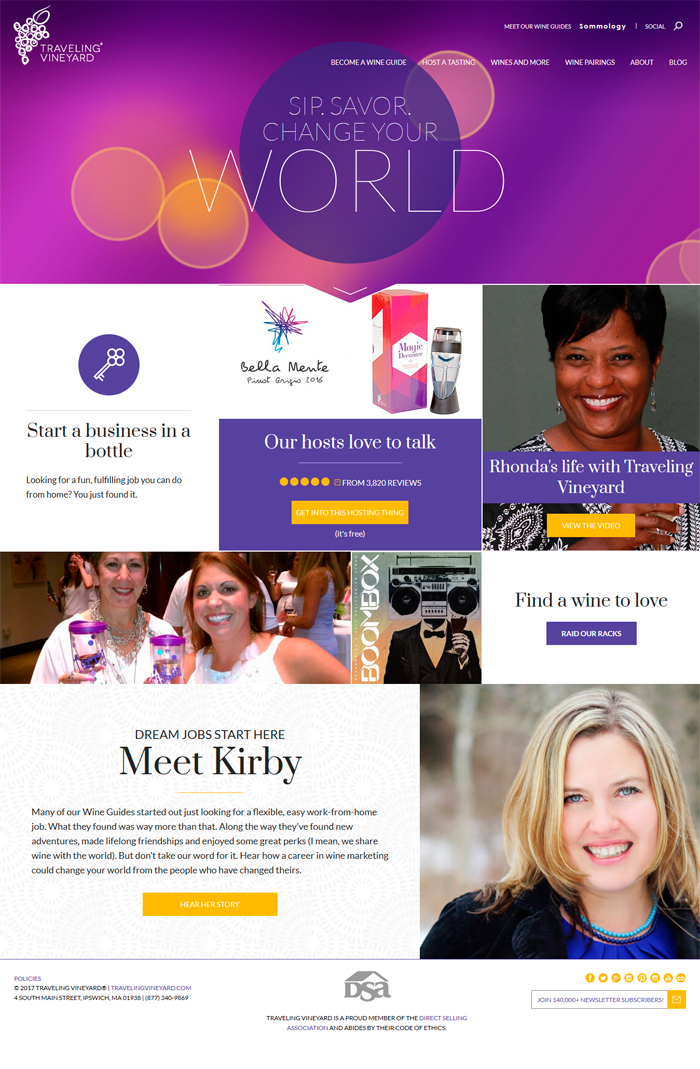
Image via Traveling Vineyard
The Traveling Vineyard lives out their brand mission in everything they do and is expressed through the language and messaging on their website. This critical change in focus in their brand mission is what delivered a dramatic increase in people becoming Wine Guides; resulting in an increase in wine sales.
Their revamped strategy became about getting people to become Wine Guides (ultimately sales reps) who share wine experiences in a relaxed home environment. Instead of focusing on getting people to sell their wines, they changed their internal culture to be one that would transform lives by providing fulfilling, fun and flexible work.
In this way, they were able to bring their customers and employees together with a more meaningful purpose. Changing their internal brand mission resulted in a 49% increase in conversion rates for Wine Guides in the first year, and 83% lead forms submission on web pages that expressed the company’s purpose.
Related: Brand Profiling: How Brand Performance and Purpose Are Inextricably Linked
2. Brand Mission Attracts The Right People
One of the greatest reasons for incorporating a brand mission, is that it helps attract the right people, for the right reasons. Who are the right people? Those that will ultimately buy from you. And of course, it’s essential to draw the right employees to your company; those that are the right “fit” for your company’s culture, and those who will add the most value to your vision.
Your brand mission aligns the internal (staff) and the external (customers).
The Airbnb Story: How Three Ordinary Guys Disrupted an Industry, Made Billions … and Created Plenty of Controversy, by Leigh Gallagher, tells of how a young brand developed into a household name because of its brand mission.
Essentially, Airbnb is a tourist booking facility, but what separates it from it’s competitors is that the focus is on making memories and creating experiences. It is this mission and message which has been and continues to be one of the key drivers behind their success.
In mid-2014, Airbnb developed a new mission — to make people around the world feel like they could “belong anywhere.”
The founders wanted Airbnb to stand for something much bigger than travel; it would stand for community and relationships and using technology for the purpose of bringing people together.
Related: The Impact of Company Brand Culture On Driving Performance and Increasing Sales
Check out the story[4] about Airbnb’s massive growth, and how their brand mission catapulted it:
Although now a household name in many parts of the world, Airbnb started as most businesses start – small. Now that they’re a well known brand name, you may be thinking their branding story may not be applicable to you.
Related: Brand Stories: 5 Compelling Examples That Sell Themselves
Even if you’re flying solo – you may be a freelance writer, business consultant, coach, author, IT consultant, or building a multi-level marketing business – you should still have a brand mission to differentiate yourself from your competitors.
Do a Google search with your niche keyword and you’ll see just how many online competitors you have, so you need to develop and use your brand mission as part of your strategy for standing out and getting attention from the people who need your service or product. As a solopreneur, it’s especially important to discover your uniqueness and leverage your personal brand identity. Otherwise, you’re just another anchovy fish lost in the ocean.
If you want direction and support empowering you to transform your brand so you stand out and increase your sales then the Persona Brand Building Blueprint™ Mastermind is the perfect fit for you.
This is a two-day brand building intensive shared with a small group of like-minded peers where you work on your brand with our leadership. In fact, over the two days, you re-evaluate your brand, codify it and create your brand strategy to stand out and attract your ideal customers from the ground up whether you’re revitalizing an existing brand or creating a new one.
This is not a theory based programme but a highly interactive fast-track course where you work intensively on your brand throughout the programme duration, under our tutelage, using our ten step system to:
- Completely re-evaluate your brand to make it much stronger so it’s highly visible enabling you to increase your profits
- Map out your brand in full so it’s codified and comprehensively documented to grow your business faster
- You leave with your total brand road map or GPS of your brand empowering you to manage your brand, stand out and attract your ideal customers so you multiply your sales
Outcome: Your brand transformed so you increase your sales.
At the end of the two-day Persona Brand Building Blueprint™ Mastermind, you leave with your fully documented brand strategy ready for implementation in your business or organisation.
If your team is larger and you’d like to include everyones’ participation in the Persona Brand Building Blueprint™ Mastermind then we also run in-house private client brand building intensives tailored to your bespoke requirements so you’re empowered to take your business further a lot faster.
Ring us today and discover how to build your winning brand to make it really stand out and increase your sales
Want to know more? Give us a ring T: +353 1 8322724 (GMT hours 9:00 – 17:00) to discuss your preferences or send us an email to [email protected]
Regardless of the size of your business, you need to know who you are, what you stand for and what you can offer your audience because the service or products you promote are not what you are really selling.
Remember, 60% of branding is about perception and only 40% is about your product or service so you must touch the heart first if you want to move the mind.
Once you understand that and begin marketing with that concept front of mind, that’s when you’ll really start generating serious revenue.
Just like a brand mission for conglomerates, a personal brand is a combination of your strengths, passions, gifts, and the purpose that you bring. In the next video by TEDx Talks, Anand Pillai provides a formula for building a personal brand, remembering that your mission is what drives your business, solo or major conglomerate:
Related: Personal Branding: We Are All CEOs (Part 1)
Smaller B2B companies can stand out from the crowd simply by providing brilliant content on their website, as the Buffer App does on their blog. A simple branding strategy for smaller businesses, Buffer is creating a cult following by publishing content that is irresistible and central to their brand mission.
Buffer’s brand mission[5] is to “create helpful, actionable content that helps people with their social media presence. To connect a community of like-minded people with passions for social media, self-improvement, and Buffer’s values. To share Buffer’s internal approach, philosophies, and culture to help create a new way to work”.
Their mission drives their brand strategy and consequently all marketing activities.
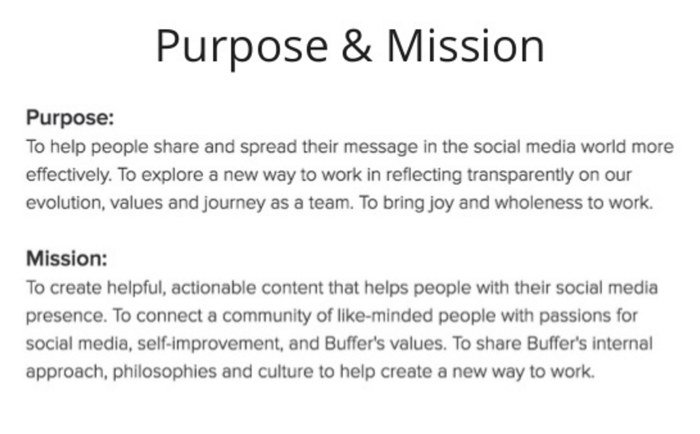
Image via Buffer Slideshare
Buffer was only founded in 2010. In 2016, their staff complement doubled from the previous year. They now boast 75 employees who work remotely around the world.
Their success is further evidenced by the results achieved with their content: one of their posts[6] has been shared 23 000[7] times and earned 210 000 likes on Facebook. Not bad for a humble team of 75…
By addressing target audience problems via blogging, and becoming known for publishing genuine value-add content, they get the attention of the people they’re targeting.
Related: Personal Branding: We Are All CEOs (Part 2)
3. Brand Mission Creates Consistency
Have you ever experienced exceptional service from a company, and the next time, expecting the same level of service, were deeply disappointed?
That’s because the brand lacks consistency. In fact, consistency engenders trust so if your brand falls short in any areas of the business or at any brand touch point, be it your brand collateral, customer facing staff, service or product delivery you undermine the power of your brand. Consequently, your sales and profitability are also immediately compromised because inconsistencies plant seeds of doubt and create bad customer experiences. Companies who boast consistent good customer experience are those who put standards in place to carry out their brand mission consistently in everything they do.
Brand awareness also depends on consistency. In fact, every aspect of managing, protecting, directing and preventing unintentional brand sabotage requires branding style guides.
Related: Brand CSR: The Business Case for Successful Branding and Social Good
If you want direction developing your brand so you can increase your profits then take a look at our online brand building eprogramme called the Personality Profile Performer™. This online course takes you through all the key steps you need to implement as you build your brand, including your brand mission. You can watch a free course preview here.

Build Your Brand Mission Using The Personality Profile Performer™ Programme with Lorraine Carter Here
If you’d like professional direction to develop your brand mission and would like to explore working with us then send us an email to [email protected] or give us a ring T: +353 1 8322724 (GMT hour 9:00 – 17:00). We’d be delighted to talk with you.
4. Brand Mission Ensures Clarity
Companies who provide the best customer service experience are driven by employees who are armed with clarity because their brand mission enables effective and fast decision making with clear judgment. Consider the front facing staff member who is shouted at by a disgruntled customer. After calming the customer down and finding out the exact issue, the employee is able to rectify the issue by taking some kind of on the spot action.
In the same way, leaders who have a clear sense of what matters most, are enabled to set priorities and determine the best path for the organization. Clarity drives commitment and dedication.
Related: CEO Brand Leadership: How Vision Drives Brand Growth
Summary
The best companies in the world to work for, and the most profitable, understand the power of the brand mission.
Developing your brand mission drives the company vision. The key benefits are brand awareness, effective lead generation, professionalism, and most importantly, providing a united purpose between employees which in turn generates multiple other benefits that collectively impact the bottom line positively to increase sales.
Related: What’s a Cult Lifestyle Brand And How Do You Create One?
Essentially, your brand mission is the driving mechanism that activates success.
In summary, your brand mission drives profits by:
- Boosting employee performance and company growth
- Attracting the attention of your ideal target audience
- Creating consistency in brand messages and service which builds trust
- Providing clarity for leaders and employees
Questions to consider…
- How does your business achieve its overall vision?
- What need does your business hope to fulfill?
- Does each member of your team understand his or her role in your overall brand vision?
- What separates you from your competitors?
- How do you touch the hearts of your customers so buying decisions are no longer about selling at the lowest price?

Build your brand strategy at the Persona Brand Building Blueprint™ Mastermind with Lorraine Carter
[1] https://www.brandingstrategyinsider.com/2016/12/how-brand-purpose-propels-brand-profits.html#.WTab1dwlHIU
[2] https://innovatenewalbany.org/branding/why-purpose-driven-companies-are-beating-the-competition/
[3] http://genuinely.co/what-we-do/case-study/
[4] http://fortune.com/airbnb-travel-mission-brand/
[5] https://www.slideshare.net/Bufferapp/buffer-marketing-culture/2-Purpose_Mission
[6] https://blog.bufferapp.com/10-scientifically-proven-ways-to-make-yourself-happier
[7] https://insights.newscred.com/branded-content-marketing-hubs/
About
Persona Branding & Design Consultants
Contact: Lorraine Carter
T: +353 1 832 2724
Carra House
Howth, Co. Dublin, Ireland
Copyright © 2007-2022 All rights reserved.
Persona Design Consultants Ltd.
Registered in Ireland: No. 201997
Member of



